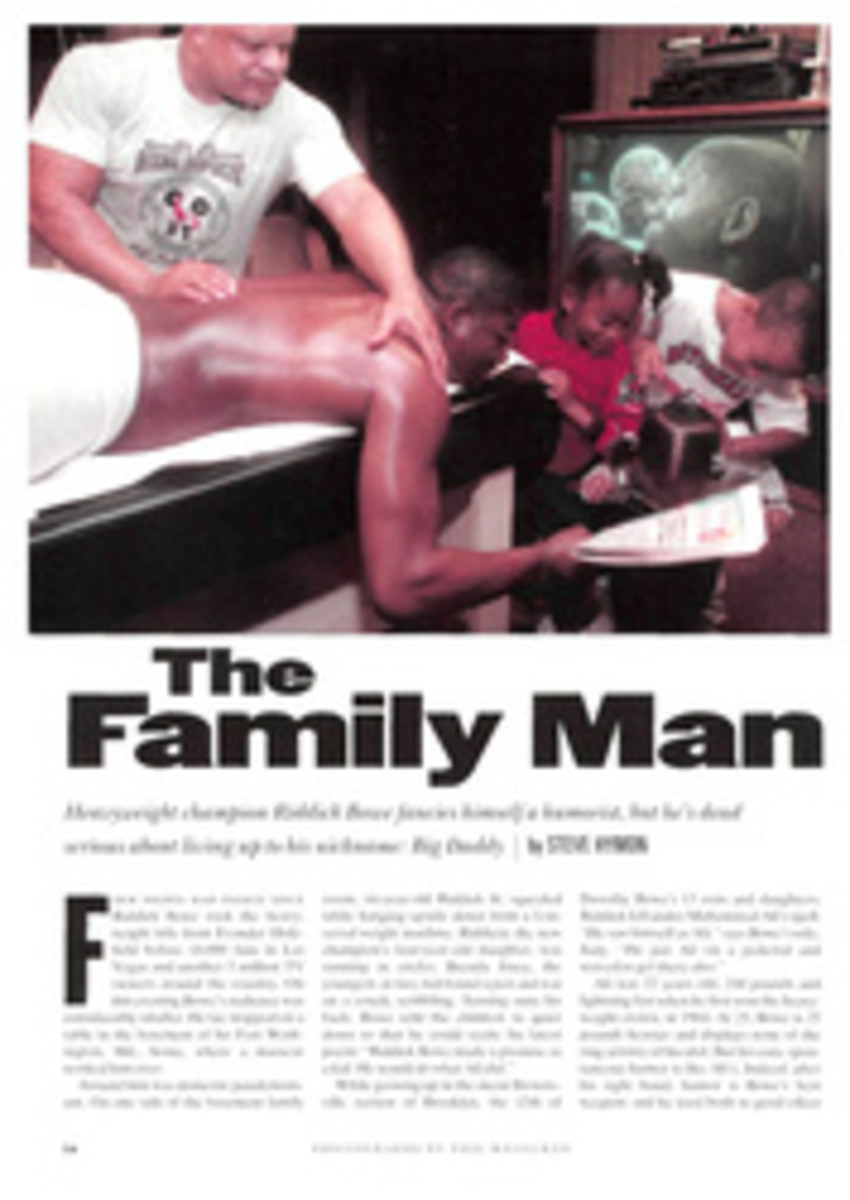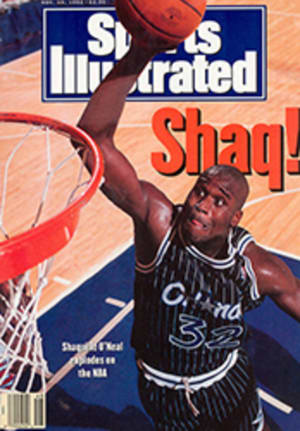
From Russia with Glove
It is late September, and cruiserweight Sergei Kobozev is 6,000 miles from home, sitting at a table in an Italian restaurant near Catskill, N.Y. The hour is late, about 1:30 a.m. The Russian's face is hard as he stares into a shot glass on the table in front of him. It is much the same look he gives his ring opponents as he bores in on them. Who knows what he sees in the shot glass? His wife, Irina, and six-year-old son, Alexander, who live in the central Russian city of Kostroma? The title he came to America to win?
After a moment Kobozev points to a place high on an empty glass, dumps two full shots of vodka into it and mutters something in Russian. Perhaps, "Where I come from, that's a real shot."
Kobozev is asked about Carl Wilson, the fighter he dispatched in two easy rounds earlier that night in Catskill while a woman in the crowd yelled at Sergei, "Go, Boris!" Under heavy pressure from the fists banging at his body, Wilson, a journeyman fighter, tried a somewhat novel approach to boxing: He threw only three punches in the first round. Now, in the restaurant, Kobozev chuckles and says, "Mishok" ("He was a bag").
Everyone at the table laughs, glasses are raised, a toast is proposed. "To Sergei, who has once again made us proud," says Kobozev's co-manager Rory Cutaia. "We look forward to you carrying a belt."
"Na zdoroviye!" The drinks are downed. A Phil Collins song plays on the jukebox. Kobozev glances at his Uncle Sam watch. Slava Trunov, who is his other manager, lights his trillionth cigarette of the night and begins to reminisce, speaking in heavily accented English: "It was exactly 11 years ago to the day I left Russia with $90 in my pocket...."
Kobozev looks on. He is the thread, the tie that binds these people together on this night. Sitting on one side of Kobozev is Trunov's wife, Anna. On his other side sits the Trunovs' 20-year-old son, Gary, a student at Kingsborough Community College, Kobozev's translator and the caretaker at the fighter's current residence in Brooklyn. At the next table is Teddy Atlas, a former trainer for Mike Tyson, hired by Cutaia to show Kobozev the ropes of American boxing.
Kobozev, 28, is 5-0 since returning to America in June of this year. (His first visit to the U.S., in 1991, was cut short after four months when he suffered a gash above his eye.) Kobozev, who was 6-0 as a professional fighter in Russia, learned to box at the age of 12, went on to become a member of the Russian Central Army team from 1985 to '90 and had been expected to compete in the 1988 Olympic Games before a knee injury sidelined him. He also has a four-year chemistry degree from the Kostroma High Military Command for Chemical Defense, which he earned in 1984. "If there was ever chemical, nuclear or biological fallout, I would get sent into different zones to test for contamination," he says.
In the last three years, since the disintegration of the Soviet Union, a number of Russian fighters have begun to make names for themselves. Yuri Arbachakov, who now lives in Tokyo, won the WBC flyweight title there last June. In this country the brothers Artemiev—Sergei (18-1-1) and Alex (6-1-1)—are lightweights slugging it out from Gallagher's Gym in Queens, N.Y., which is one of the places where Kobozev trains. There, too, is cruiserweight Yuri Vaulin (13-2), who rocked Tommy Morrison in a fight in Atlantic City in April of last year before falling in five rounds. And heavyweight Alex Zolkine, who fights out of Columbus, Ohio, has quietly achieved a 13-0 record.
On a freezing day in January 1990, Cutaia, who was in Russia to find fighters, boarded a plane for the three-hour trip from Moscow to the city of Barnaul, on the Siberian plains. "First, I'm flying to Siberia in the middle of the winter," says Cutaia of the memorable flight. "Second, the plane looks like it's something from the 1940s, and third, it was incredible to me that on an airline, people didn't have scats and were standing in the aisles."
That night Cutaia watched Kobozev—by then a pro—knock out his opponent in the second round, and he decided that Kobozev would be the first of several fighters he would bring to the U.S. Cutaia formed a partnership with Trunov, who is in the import-export business. To date, the partnership has spent more than $100,000 developing four Russian fighters: Kobozev; heavyweight Igor Bistritzky, a recent arrival to the U.S.; and two middleweights who have since returned to Russia.
For Kobozev, the decision to leave Russia wasn't very hard. "I was a little hesitant," he says. "But to achieve a certain level in boxing, I knew I could only do it in the States."
Oddly enough the yardstick used by unsophisticated Americans to measure a Russian fighter is Dolph Lundgren, the Swedish actor who played Rocky's steroidal Soviet opponent in the 1985 film Rocky IV. In fact, the European style of boxing is very different from—and basically inferior to—the North American style. European fighters are not as quick as American fighters; they are more open and rely heavily on the use of a circling left hand to set up a big right uppercut or hook. "There's a reason for it," says Atlas. "They were all trained under one program. There's no diversity like in the States. Sergei feels that he should let nothing slow him down while he is here. He's steady, and he's strong mentally. He has the ability to catch guys clean. It's his timing that needs work. It's learning to know when to throw the punches." Or, when not to be the gentleman he ordinarily is. Kobozev must realize that if someone hits you with a low blow, "you hit him back—lower," says Atlas.
Kobozev had his timing down perfectly when he dropped a hammer of a right hand on Dwayne Hall to knock him cold in the second round of a fight in Atlantic City on Aug. 14. "I noticed after that fight that he started taking a few things for granted," says Atlas. "He wasn't using his jab, he was looking for one punch to knock the guy out. What shocked me was that this had never happened before. So I jumped all over him and said, 'What are you going to be—a spoiled American brat now? Now after one fight, one knockout, you're on TV. You're learning some of the vocabulary. Now are you going to start using excuses, too?' And he came back to me and said, 'You're right. I am sorry.' "
On a fall day in Brooklyn, Kobozev opens the front door of the Brighton Beach house where he lives with Bistritzky and which is paid for by Cutaia and Trunov. He is wearing only bikini briefs and a smile as he takes in the 35° morning air with a deep breath. He greets a visitor in his high-pitched voice.
In the house, Kobozev and Bistritzky live like a couple of, well, bachelors. This morning, while waiting for Gary Trunov to pick them up and take them to the gym, they sit in the kitchen, in their underwear, sipping tea and flipping through a women's uniform catalog that arrived in the mail. In the empty living room, Family Feud is on the television set, playing to an orange carpet and a couch that looks like a leisure suit on legs. "I have to go to the supermarket with them. I have to go to the barbershop with them. Then I have to go to class," says Gary, when he appears a few minutes later. "These guys would starve without me." Gary is not really complaining. The truth is, he has caught the boxing bug and will make his amateur debut as a light middleweight this winter.
On the way to Gallagher's, Gary takes the visitor on a tour of Brighton Beach, an area of Brooklyn that is home to some 50,000 Russian immigrants and is known as Little Odessa. "Everybody is Russian here," says Gary. "See that? Cafe Arbaty? That's a street name in Moscow." Nearby is the Metropol, a Russian nightclub where Kobozev has a night job as a bouncer.
The neighborhood and the job help Kobozev get by because, though he can understand English, he can't yet speak it. So far, his ring career is going well. Kobozev KO'd Doug Davis on Oct. 23 in Bushkill, Pa., and will face an as yet unknown opponent in Atlantic City on Dec. 10. But the big money and big fights are still at least two years away. Which means two more years away from home, two more years with Cutaia and Trunov footing the bills. When asked how long he will stay, Kobozev says, "as long as I can." Asked if he plans to bring Irina and Alexander to the States, he says, "It is a very serious question. I haven't thought about staying yet."
Later Kobozev walks into his bedroom, which is bare except for a bed, a chair with a tape player on it and a dresser. His Central Army uniform hangs in the closet. From a dresser drawer, he pulls out a little white book that contains a dozen or so pictures of his wife and son. In one photo, Sergei, Irina and Alexander are in a park in Kostroma, posing next to a six-foot-tall Stuffed bear. Alexander and Irina are huddled against the bear. Kobozev, a.k.a. the Russian Bear in U.S. fight circles, stands to the side and stares off into the distance.
PHOTO
JOHN IACONO
From 1985 to '90 Kobozev boxed for the Russian Central Army.
PHOTO
JOHN IACONO
Kobozev hopes he'll meet foes who put up a better fight than Wilson did in September.
PHOTO
JOHN IACONO
Atlas is helping introduce Kobozev to boxing in America.

